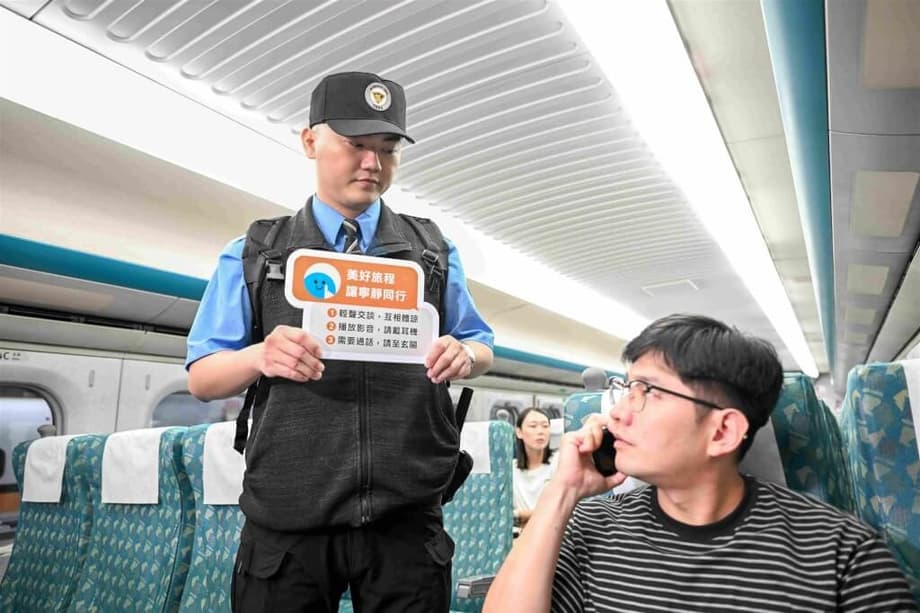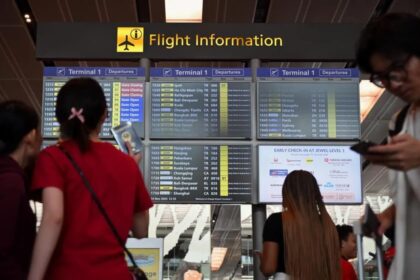A push for quieter rides sparks debate
Taiwan is testing a new social contract on its fastest trains. After the Taiwan High Speed Rail (THSR) introduced systemwide quiet rules on September 22, a Ministry of Transportation and Communications official stepped forward to defend the policy amid concern from parents. General Secretary Shen Hui-hung said the measure targets controllable behavior such as phone calls and media played without headphones, not the unavoidable sounds of infants or travelers with medical needs. Her remarks followed a widely shared account of a mother asked by staff to lower her children’s voices, which fueled claims that families were being singled out.
The quiet rules apply across all cars, including Business Class, Reserved, and Nonreserved seats. Trains now encourage passengers to keep mobile devices on silent, use earphones for audio and video, and step into the gangway when taking calls. THSR has promoted the change with illustrated seat pocket cards, in-train displays, and announcements, and at first used staff holding reminder placards. The company has since adjusted how reminders are delivered, while keeping the policy in place.
THSR leaders frame the change as part of raising ride quality. Company chair Shih Che has said he wants carriages to be suitable for rest and reading, and that frequent loudspeaker reminders had become a distraction. The new rules put the onus on riders to regulate noise and let crews step in when needed. Repeat refusal to comply can lead to termination of the passenger contract and removal from the train after warnings, a step rail systems in Japan and Europe also reserve for persistent disruptors.
What changed on the trains
The quiet initiative formalizes etiquette that many riders already practice. It spells out which behaviors can disturb others and where certain activities are allowed, while making clear that unavoidable sounds from babies or passengers with health conditions will be handled with empathy.
- Keep phones and devices on silent mode inside carriages.
- Use earphones for audio or video on personal devices.
- Move to the gangway to make or answer phone calls.
- Speak softly to avoid disturbing nearby passengers.
- Cooperate with crew reminders. Those who repeatedly ignore guidance may be escorted off after warnings.
THSR paired the launch with a three month promotional period focused on education. Information appears on seat pocket cards, overhead LED signs, station screens, and the company website. The company also reduced frequent noise related announcements that many riders had found counterproductive, while giving crews a clear framework to address disruptive behavior.
Officials stress the policy draws a line between controllable and uncontrollable sounds. Staff are instructed to approach adults who are playing audio aloud or speaking loudly, to invite callers to use the gangway, and to offer assistance to families or travelers who need extra support. On crowded trains, staff may encourage texting instead of calling to keep traffic in vestibules manageable.
What officials are saying
Shen Hui-hung, general secretary at the transport ministry, said the goal is mutual respect. She underscored that the rules focus on behavior adults can manage, not on unavoidable situations involving infants or people with medical conditions. She also recounted a recent ride in which children’s voices did not disturb the carriage and said staff accommodated passengers with pets within existing rules.
“The policy addresses behaviors adults can control, not the unavoidable noises of infants or passengers with medical needs. We ask riders to show understanding and courtesy toward one another.”
THSR chair Shih Che has framed the policy as a service quality upgrade that supports rest and reading while discouraging disruptive use of devices. He said the company wants to move away from repeated announcements and toward clear expectations for quiet conduct.
“We hope to create an environment suitable for rest and reading. These changes encourage self discipline so everyone can enjoy a peaceful journey.”
Shih Chung-liang, the minister of health and welfare, said his ministry asked transport authorities to supervise the company’s response and continue monitoring concerns from parents and caregivers.
“We asked the transport ministry to supervise the company in addressing the controversy and will continue to monitor the situation.”
Are children being singled out
Public debate flared after a social media post described a mother traveling with two young children who was shown a sign by staff asking her to lower their voices. The mother reportedly moved one child to the doorway while leaving the older child in the seat, which sparked accusations that the quiet rules make trains less welcoming to families. Parents have voiced anxiety about stares from other passengers if a child fusses or cries, and some have proposed designating a family friendly carriage.
THSR has said the rules do not restrict children or those with special circumstances. Crews can offer small items like stickers or snacks to help calm young children, and are trained to approach situations with care. Shen’s account of a recent ride, where children were not disruptive and pets were accommodated within the rules, aligns with the company’s stated approach that quiet expectations focus on controllable behaviors.
Data shared by the company show that cases involving infants and children are rare compared to other sources of noise. Most reminders target adult controlled activities. Phone calls and media playing without headphones represent the bulk of issues, with a smaller share involving groups chatting loudly. These patterns suggest that simple changes in personal phone and media habits can resolve most disturbances.
Early results from the rollout
Early figures from the first weeks offer a snapshot of enforcement. From September 22 through the following Wednesday, crews issued about 13,000 reminders, which the company said comes out to fewer than five per train on average. Nearly half involved passengers talking on the phone in the carriage. About one quarter were riders playing audio or video without headphones. The remainder involved conversations loud enough to disturb others. Incidents involving infants and children were described as very rare.
THSR has also indicated strong public backing for the initiative. Company feedback channels point to high support among riders for quiet expectations. Surveys cited by the company show broad approval of the shift to earphones and gangway calling, and many passengers have welcomed fewer onboard announcements as a quality of life improvement.
The pattern in the numbers matters for how enforcement proceeds. If the primary problem is audible media and calls, then clear messaging and consistent reminders can address most disturbances. Crews can reserve interventions for adults whose actions affect many people, rather than families managing a momentary fuss or carers guiding a passenger who needs special assistance.
Enforcement, rights, and etiquette
Quiet rules sit within THSR’s passenger transportation contract, which sets out rights and responsibilities for both the company and riders. In practice, crews begin with a polite reminder. If a passenger refuses to cooperate, staff may issue further warnings. For repeat or serious noncompliance, the company can cancel the transport contract and ask the person to disembark at the next station. This step is reserved for cases where a traveler disrupts others after multiple reminders.
Riders who want to check the do’s and don’ts, including rules for pets, luggage, musical instruments, and special assistance, can review the official guide on the THSR website. The English passenger guide is available at this link: THSR Passenger Guide.
For most travelers, a few etiquette habits will help. Keep alerts and ringtones muted. Put on earphones before pressing play. If a call comes in, head to the gangway or send a quick text if the train is crowded. If a child becomes fussy, give it a moment and, if needed, take a short walk to the doorway. Staff can help when asked. These small adjustments support a quieter cabin without placing a burden on families or those who need care.
How other rail systems handle quiet space
The THSR policy mirrors practices long established in Japan. On the Shinkansen, riders are asked to use earphones for media and to make calls in the vestibule between cars. Crew reminders are common, while relying on passenger courtesy to keep the cabin calm. Many European services also promote quiet zones or quiet coaches on select routes. Experience there shows that success depends on clear rules, consistent messaging, and a willingness by crews to step in when needed.
These approaches acknowledge how smartphones and streaming have changed travel. A device that fits in a pocket can fill a carriage with sound. Earphones turn the same activity into a private one. The shift is not about silencing conversation. It is about reducing intrusive noise that travels well beyond a single seat.
A shared standard is easier to follow than one based on personal tolerance. When everyone knows that calls belong in the gangway and videos require earphones, disputes drop. Carriages stay more comfortable for passengers who are resting, reading, or working, while those who need to talk can do so in a space designed for it.
What could change next
Lawmakers and ministries are weighing how to refine the approach. Chinese Nationalist Party legislator Chen Ching-hui urged the transport and health ministries to draft more flexible measures within a month. Chen welcomed the intent of quiet travel but argued that interactions with families require extra care to avoid stigma and anxiety.
“Children express needs through crying, so soothing alone is not enough. Staff approaching crying children would only draw attention from other passengers and label the family as causing a disturbance.”
THSR says it is reviewing how reminders are delivered. The company plans to keep messages on trains and at stations, update seat pocket cards with clearer graphics, and reduce the need for staff to hold reminder placards in aisles. Some passengers and commentators have suggested experimenting with a family friendly car on select services. That option would require careful planning to avoid reinforcing stigma while preserving quiet across the rest of the train.
At a Glance
- THSR’s quiet rules took effect on September 22 and apply to all carriages, including Business Class, Reserved, and Nonreserved.
- Passengers must use earphones for audio or video and make phone calls in the gangway, with phones set to silent in carriages.
- Officials say the policy targets controllable behavior by adults and is not aimed at children or people with medical needs.
- Crews issued about 13,000 reminders in the first weeks, fewer than five per train on average.
- About 49 percent of reminders involved phone calls, 24 percent were for media without headphones, and 27 percent were for loud chatter.
- Repeat refusal to follow reminders can lead to contract termination and removal from the train after warnings.
- Ministries have asked THSR to address parental concerns and to keep monitoring the policy’s impact.
- THSR is adjusting enforcement methods, keeping onboard and station reminders while reconsidering staff use of placards.












